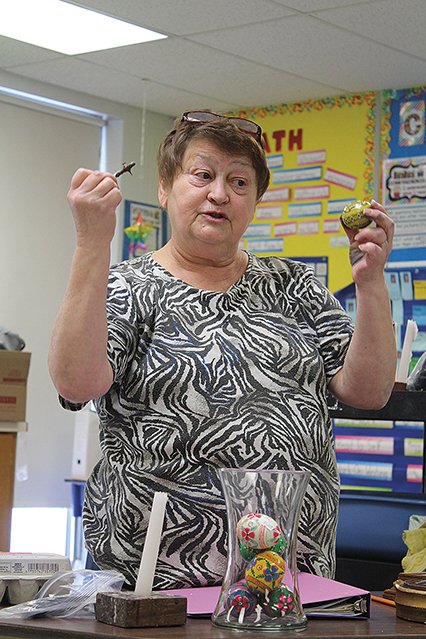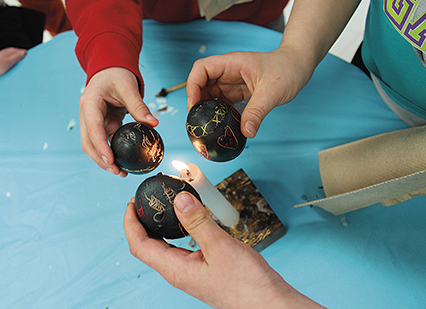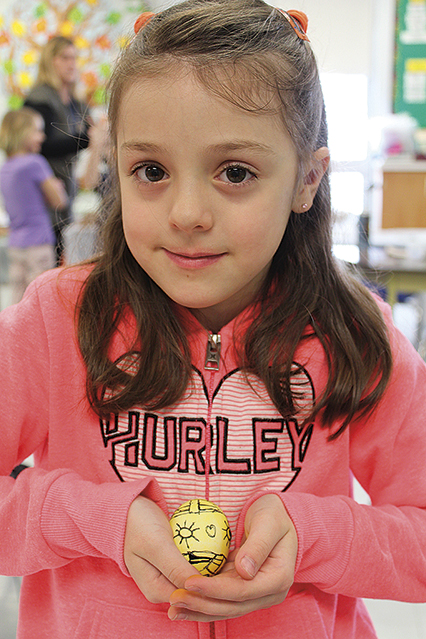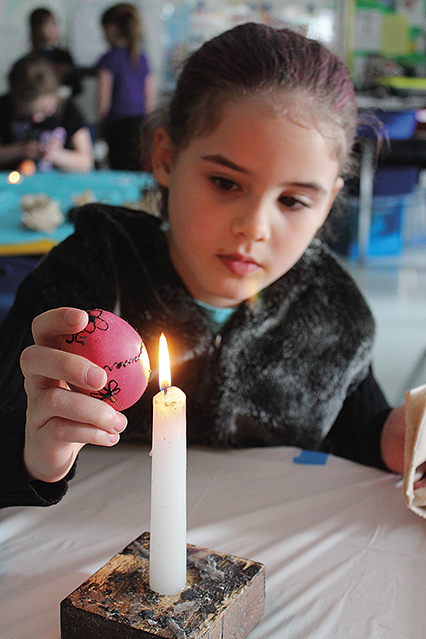Page Content
Madison McRobie (Photos by Patricia Gagnon)
Grade 2 students at Bon Accord Community School got a lesson in traditional Ukrainian Easter egg decorating on Tuesday, March 22. Leona Petherbridge, a local bus driver and retired school librarian, taught the class the traditional Ukrainian method of “writing” pysanky using beeswax, a candle, dyes and a stylus or kistka. This was the culmination of a project-based learning initiative that delved into various founding cultures of Canadian communities.
Pysanky history and symbolism
Decorating Easter eggs (pysanky) is a very old Ukrainian folk art whose beginnings reach back to antiquity. In attempting to understand creation, ancient people developed myths in which the egg was perceived as the source of life, the sun and the universe. Although such similar myths are found in many cultures of the world, Ukrainians today are one of the few groups of people who still strongly adhere to many of the ancient traditions associated with the egg.
 Leona Petherbridge
Leona Petherbridge
The Ukrainian pysanka (from the word pysaty, to write) was believed to possess an enormous power not only in the egg itself, which harboured the nucleus of life, but also in the symbolic designs and colours that were drawn upon the egg in a specific manner according to prescribed rituals. The intricately coloured eggs were used for various social and religious occasions and were considered to be a talisman, a protector against evil, as well as a harbinger of good.
 The symbolic ornamentation of the pysanky consists of geometric motifs, with some animal and plant elements. The most important motif is the stylized symbol of the sun, which is seen as a broken cross, a triangle, an eight-point rosette or a star. Other popular motifs are endless lines, stylized flowers, leaves, the tree of life and also some animal figures such as stags, horses or birds. The Christian influence brought elements such as the cross, the church and fish.
The symbolic ornamentation of the pysanky consists of geometric motifs, with some animal and plant elements. The most important motif is the stylized symbol of the sun, which is seen as a broken cross, a triangle, an eight-point rosette or a star. Other popular motifs are endless lines, stylized flowers, leaves, the tree of life and also some animal figures such as stags, horses or birds. The Christian influence brought elements such as the cross, the church and fish.

Sara-Jane Ritchie
The most popular method of decorating pysanky is the use of the wax resist or batik. A specialized instrument called the kistka or ryl’tse is used to write the design with hot wax. The dyes used in the process also had a symbolic meaning. Red symbolized the sun, life, joy; yellow stood for wealth and fertility; green was the symbol of spring and plant life. In the not-too-distant past, artisans prepared their own dyes using natural products such as the bark of oak or ash trees, twigs of sour apple trees, saffron or willow tree leaves. Today, chemical dyes are used.

Serena Gibson
Material courtesy of the Ukrainian Museum (www.ukrainianmuseum.org).
